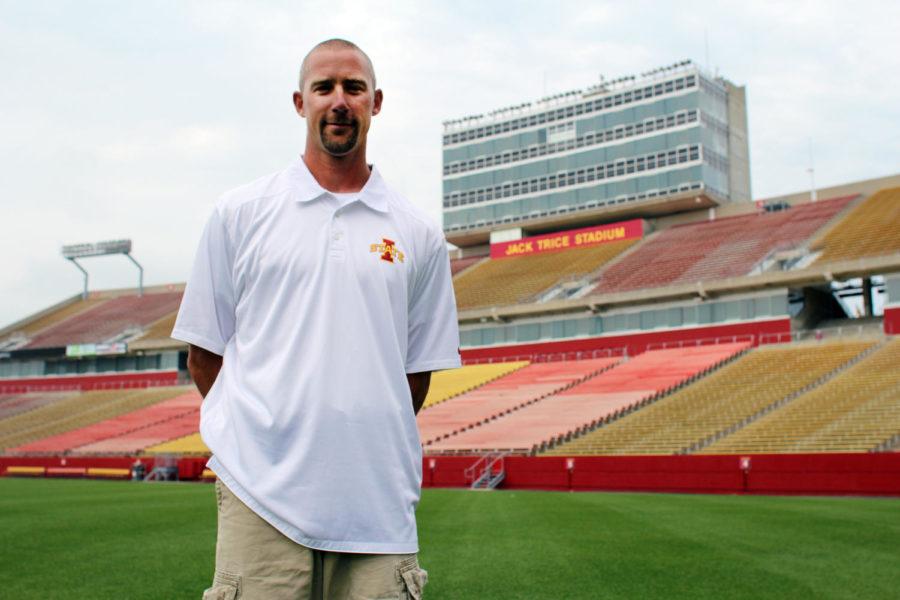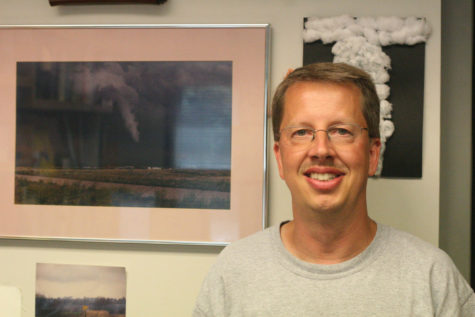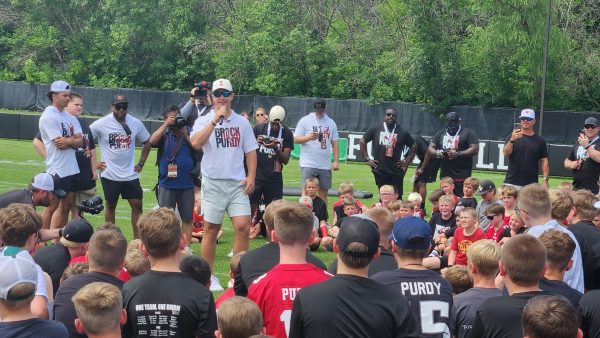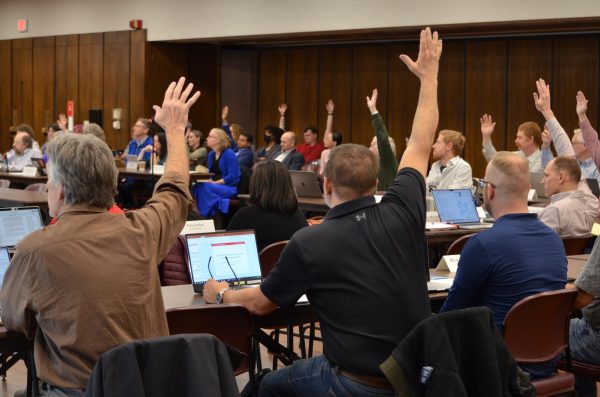One-on-One with Tim VanLoo
Tim VanLoo, the current manager of turf and grounds for ISU athletic department, has been with Iowa State for five seasons and has been working with turf and grounds since graduating from graduate school.
July 23, 2014
Tim VanLoo, the current manager of turf and grounds for the ISU athletic department, has been with Iowa State for five seasons. He oversees the maintenance and repair of all practice and competition fields.
Could you describe your job?
So my job is to manage all the athletic fields plus surrounding landscapes and surrounding green space of all of our complexes; we have the cross country course, Cyclone Sports Complex, Jack Trice Stadium, Johnny Majors practice field and then we have Field of Dreams practice fields across the street — so about 75 acres of turf and landscape areas.
What made you get into this kind of area? Something you chose or something that just happened?
Coming out of high school I grew up on a farm in Michigan and played golf in high school and wanted to get into turf management as a golf course superintendent, which slowly progressed as I got into college. [I] figured out that athletic fields was an avenue, helped build Spartan Stadium’s field from artificial to natural and that’s really what sparked my interest and gravitated to the sports field industry and have been in it since 2000.
When you came to Iowa State? Where did you start out?
I was hired here as the athletic field manager in March of 2010.
Any areas that you tell are interesting facts about your job?
A lot of people don’t realize that this is a profession. We have eight students that work for me currently — well six in the summer and we’ll bump up to eight or nine in the fall and spring. And they’re all turf grass majors with an emphasis in sports field. They fully realize the emphasis and potential for a career, but there are a lot of people that just don’t understand that there is a person who is a professional who has been educated and that takes care of the athletic fields, so it’s one of those things where people just don’t think about it a lot. We’re at all levels — high schools, municipals, rec and all the way up to professional levels. There’s a group, sports fields management association that I’m a part of that’s nationwide that helps us to get that education and kind of stuff. It’s a profession, there’s programs in a lot of major universities that cater to it, Iowa State being one of them.
When you came to Iowa State, who did you start out working with?
Who hired me was Mike Andresen, who held this position before me. He got hired and moved up into administration, so he kind of hired his own replacement. I knew Mike through our national organization. I was already the head manager at Northwestern University. That’s where I went right after graduate school, so I had been there for three years and had been talking to Mike and interviewing, so he decided, offered me the position and my wife and I decided that it was a good choice. Since being here I’ve tried to insert myself into the turf program, so I teach irrigation classes every other fall for Iowa State, so the turf professors have been very welcoming, and then having a guy like Mike being my boss and mentor has worked out very well.
Do you foresee yourself ever leaving Iowa State to pursue higher than university field management?
So for me career-wise, when I was going through graduate school, I wanted to be a major university field manager. I accomplished that right out of college with Northwestern. When I came here, it was more of a family decision. The reality of it is I’m not really looking to go anywhere. We like it here. There is a variety of things that keep it busy and I like it that we are probably going to be the only ones that have a fully irrigated cross country course. We have a chance to do something that other places don’t. So I’m not necessarily looking, but you can never rule anything out.
Has there been any funny stories that have stuck out to you?
We have all students, so a lot of times you learn from mistakes. So there’s things that happen that shouldn’t happen that happen and maybe’s there’s a new guy on a tractor and he didn’t realize how fast the air fire dropped and all of a sudden you’ve got aerified concrete. So there different things like that that happen all the time, but I can’t see there’s one in particular that was really funny.
Is there room for error, and you’re getting ready for a game and something happens, what does that look like?
It depends on the mistake. Probably your biggest fix would be a hydraulic leak on the field from a mower, that would be very difficult to fix right away. If you mess up painting a logo, as long as you don’t let the paint dry, it’s pretty easy to fix that. It depends on the mistake, but a lot of times what we try to do is make our mistakes and then learn to paint other places or adjust so when it’s on Jack Trice and preparing there aren’t any mistakes made. So some mistakes you can fix, some would be a little more difficult, but the reality, being a natural grass field, you can always fix it. It’s a living growing sod. You can always do different things. We have yet to sod but there’s always this backup you can do. With it being artificial, it’d be a little more difficult to do things right before a game. There’s always ways to fix things.
What’s a typical pregame field prep?
So a lot of the preparation is this time of the year. And right now it’s really just trying to get the field to peak in readiness. So we’ve spent a lot of time cultivating so the soil is going to drain correctly in the fall. Actually, game weeks are the most labor-intensive things we do on the field. It takes us about 55 hours of manpower to paint the field with about 160 to 175 gallons of paint. So painting is a very costly and labor-intensive thing to do to the field. Fortunately, we only have to do it seven or eight times to the field, but that is the biggest thing is finding a labor of time for a couple of days. We usually can do it Wednesday [and] Thursday [or] Thursday [and] Friday before a Saturday game. If you have in climate weather, then that can become a little bit of a challenge finding the right time or if you have a snow fall like last year, that was a lot of time to get the field cleared, painted and ready for a game.
What is the operating budget for Jack Trice maintenance?
For Jack Trice we end up spending $30,000 to $33,000 a year and about half of that is your labor and paint costs. So that’s really one of the most expensive parts.
We want reader to realize that Jack Trice isn’t the only thing you manage. Could you talk about what you do for other fields and surrounding areas?
So we have our softball field, Johnny Majors field and Jack Trice are all very similar. They are all sand-based systems. Softball is considered a sand cap, but we end up managing them very similarly, so those three fields are all treated at a very high level. There are certain things you have to do culturally, there are certain things you have to do with fertility, so those are actually treated very similarly. Similar mowing heights, similar cultivation and similar pesticide application techniques. Then we have our row areas that are sand cap as well, and we mow them a little higher so they are not managed as intense. Then we have two native fields, Field of Dreams, and then we have our practice soccer field which is treated differently. All are treated differently with the growing media, but all are treated intensely. With cross country, the irrigation is being installed this year and should be ready to go by the end of August with the pump station being delivered. So you’re talking 20 acres of cross country course that will be fully irrigated. The 10 meter wide course, all throughout the thing will be irrigated. We will be able to lower the height of cut out there and manage that more aggressively to where we can have our athletes running on something similar to not necessarily Jack Trice but something in that kind of caliber of grass. That’s the overall goal for our goal for our team, to give our athletes something to run on that is even throughout the course. There was no irrigation the past two falls since it’s been very dry and it’s a natural area so it gets kind of clumpy and athletes could maybe potentially get injured and it become very hard, so this summer it’s been a little different. It’s been plenty wet so a system allows us to control the water out there a little better so our athletes can have a better running experience.
In the five seasons that you have been here, have there been any breakthroughs in the development of Jack Trice’s field?
It was resurfaced in 2008, so there were some things culturally we did right when we got here. They were doing them before, but trying to get through that sod layer to get that soil that came in with the sod layer out so you can replace that with the correct sand that the field was built with so it can become uniform. So really it took us probably till 2011 to get the field to where I really like it and then this year has been a particular struggle because we had a lot of winter kill and as hard as that winter has been we had to start from scratch for about 35 percent of the field. So we’ll be using the entire summer to get the field ready. It’s getting close now — I wouldn’t say it’s ready, but it’s close. This was a challenging year because we started from scratch for about 35 percent of the year.
Do you foresee Jack Trice ever becoming an artificial field?
It would be a terrible tragedy. Financially it would not make sense for the amount of money that we spend on this, it just would never make sense for the amount of events we have. Coach Rhoads and I have a good working relationship, he really likes natural grass. I don’t see it being an issue. I also see it as my job to never give them an excuse to go that way. If I’m doing my job correctly, my guys are doing their jobs correctly, the field always looks good, plays consistent, then I don’t ever see a reason to go down that road. The reality of it is, I don’t see it happening. With this being an agricultural school and having one of the top turf grass programs in the country, there’s other things that play into that. I actually think artificial turf will go back the other way and more stadiums will go back to natural turf. The players like it, surveys show. With concussions and those sort of things, this field is going to be half as hard as what an artificial surface would be. As long as we are doing our job right, I don’t think that will be down the road.
















